There are only three things to think of when you're considering landscape lighting. We call them the three S's: safety, security and sexy. Safety lighting keeps you from breaking your neck (watch out for that step!), security lighting discourages thieves and the Boogie Man (by illuminating dark corners), and sexy lighting provides, well,
sexiness. Mood. Ambience. Flavor.
Spice.
The first two S's are straightforward — it's the third where the nuance comes in.
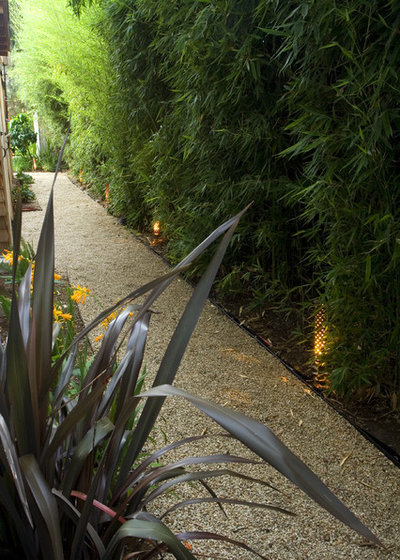
Shades Of Green Landscape Architecture
1. Safety LightingGrab a flashlight and walk your garden at night. Where are you likely to trip? To walk off the path into the darkness? To back the car off the driveway? To need access on a somewhat regular basis (for instance, the trash storage area)? Also look to see if wayfinding is clearly delineated: Think in terms of getting from point A to point B without breaking your neck.
Finally, revisit these same points but as though you'd never seen the garden before, then tweak your lighting plan to assure that visitors can safely and easily negotiate the dark as well.
2. Security LightingNow look at your yard and consider where you'd like to eliminate dark corners — places where someone could hide or the spot where the coyotes hop the fence. The amount of lighting you need for this function depends on your comfort level and your situation, but it's best to avoid prison-yard levels of illumination.
Path lights, subtle style. Path lights are small light fixtures along the edge of a walkway, a driveway or another type of path. There are lots of styles to choose from. Pick a style that complements your garden and house — or pick one that just "disappears" in the landscape. I tend to be fussy about the light
a fixture makes, versus looking for a fixture that makes an architectural or artistic statement. Avoid creating a runway effect by staggering light, setting some higher and some lower, placing some nearer and some farther from the path and/or softening the fixtures with vegetation — as in this photo.
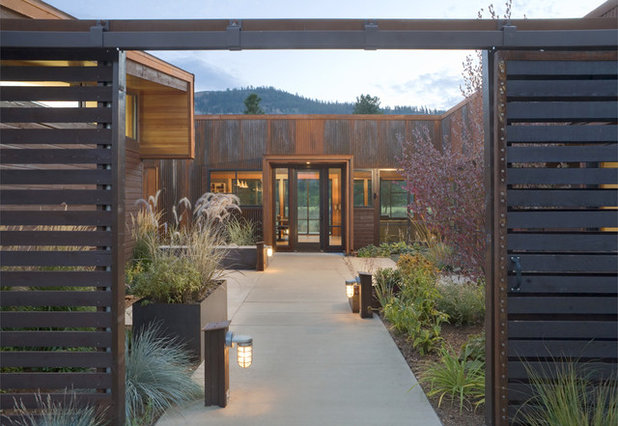
Prentiss Balance Wickline Architects
Path lights, bold style. Sometimes subtlety is called for; take the light fixture that recedes modestly into the plantings in the previous photo. In this landscape, however, the visual weight of the light fixtures, standing proud along the walkway, plays beautifully with the surrounding architecture, adding to the overall composition while drawing visitors up the walk to the front door.
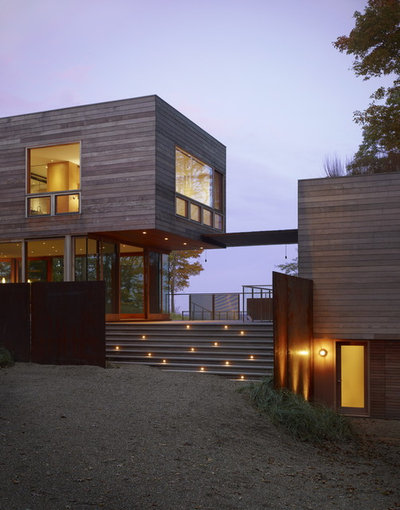
Wheeler Kearns Architects
Step and deck lighting. Built-in lights make it easy to navigate at night. Incorporate fixtures into stair risers, underneath railings and on posts.
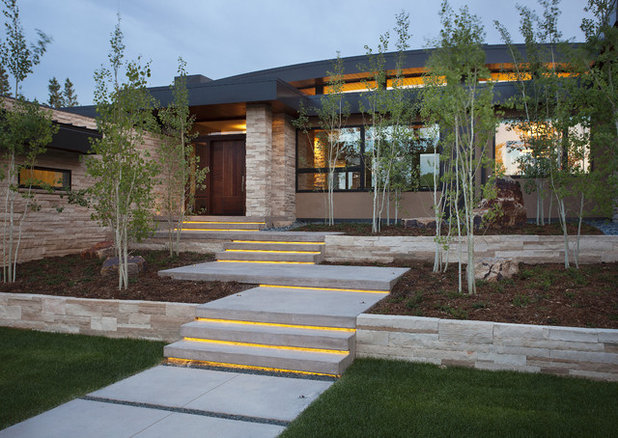
186 Lighting Design Group - Gregg Mackell
These step lights make the steps appear to float ... ahhhhh.
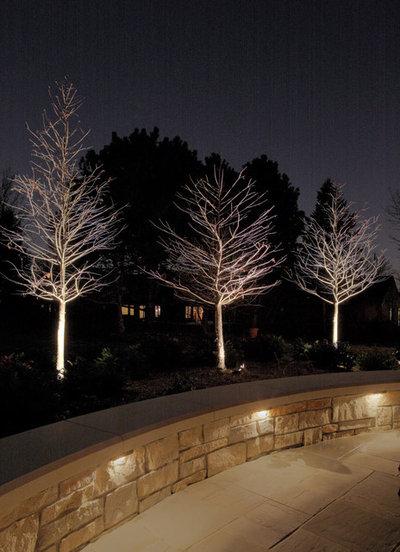
McKay Landscape Lighting
3. Sexy Lighting Now we're on to the fun stuff. Assess the cool "targets" in the landscape: a beautiful tree, a rough stone wall, a piece of art. Now think about the effect you want. Do you want to call out the architectural structure of a tree? Project plant shadows on a wall or on the ground? Highlight the rich texture of a stone wall? Sexy lighting
is what you want!
You'll hear a lot of vocabulary in the landscape lighting world. Some of the terms relate to the orientation of the lighting (downlighting, uplighting, backlighting); some refer to what you're lighting (step lighting, path lighting); some refer to why you're lighting (accenting, highlighting, spotlighting); and others refer to the lighting effect achieved (grazing, moonlighting, silhouetting, shadowing). We'll break it down to three basic lighting "moves."
- Uplighting. Hit the target with light from below. The light fixture is mounted below or at ground level or up on the target itself.
- Downlighting. Mount the light fixture high in a tree, a trellis or an eave to illuminate a wide area. This technique creates ambient light that is perfect for backyard entertaining as well as for safety and security. Hang a wide-angle, low-intensity light in a tree or trellis to cast shadows on the ground similar to moonlight (called moonlighting).
- Directional (transverse) lighting. Aim the light at an angle to the target. Low-angle light picks up surface texture (grazing) and/or creates shadows (shadowing). Use directional lighting to create a silhouette (silhouetting) or to illuminate garden art, signs, addresses or focal-point objects.
In this photo, uplighting adds drama to the nightscape. A light fixture placed at the base of each tree shines up the trunk to create a striking effect. The sexier the tree, the sexier the effect.
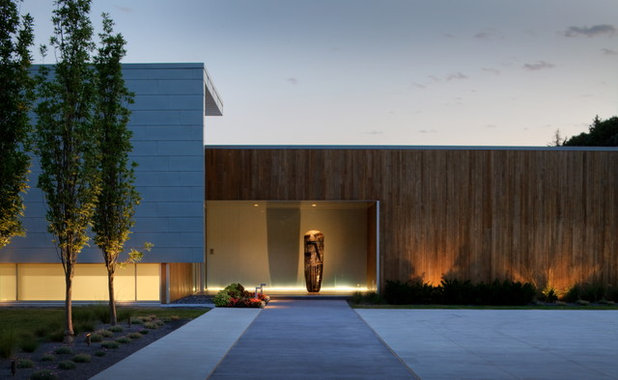
McKay Landscape Lighting
Low-angle uplighting grazes the wall, drawing attention to this home's siding material, projecting plant shadows and balancing the strong light emanating from the backlit frosted window glass on the left side of the photo.
Subtle pathlights add additional light exactly where needed for someone to safely negotiate the step up to the front entryway. The art in the entry is down- and uplit for drama, illuminating the object itself and projecting its shadow on the wall behind.
Note the line of light at the base of the foyer wall behind the art object. This striking strip lighting accentuates the strong geometry of the architecture beautifully.
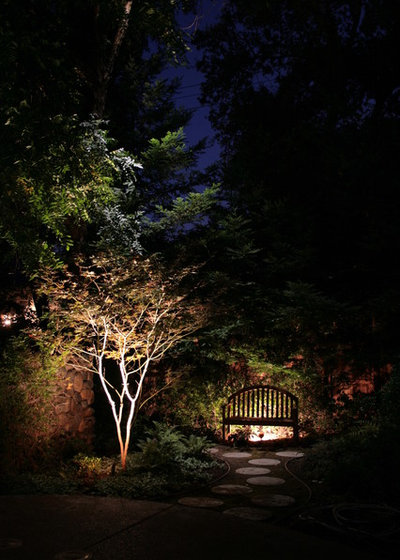
Viewpoint Lighting
Uplighting is used to illuminate this tree. Silhouetting is used to show off the bench. (Consider lower-wattage lamps for a subtler effect.)
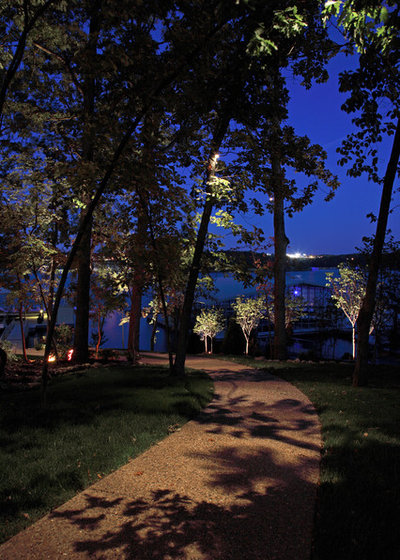
McKay Landscape Lighting
Bringing It All TogetherDownlights placed among these tree branches give the feel of moonlight on the path in the foreground.
Uplights placed at the base of the tall pines add depth to the night landscape as well as ambient light for safety and security. The branching structure and the light bark color of the small deciduous trees in the midground make them ideal targets for landscape lighting (of the sexy
variety).
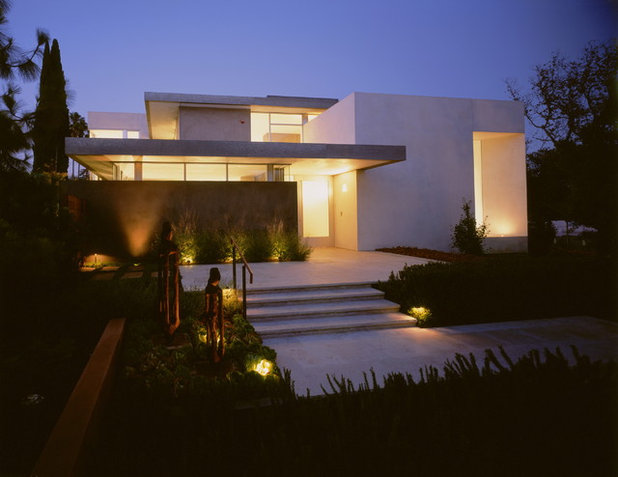
Ehrlich Yanai Rhee Chaney Architects
Tip: Multiple sources of light create a balanced and cohesive composition.
Path lights, backlighting from within the house, uplights grazing the site wall and downlights in the eaves combine seamlessly to draw someone up the path and to the front door safely, eliminating any dark, creepy corners, adding drama and painting a balanced, cohesive and striking nightscape.
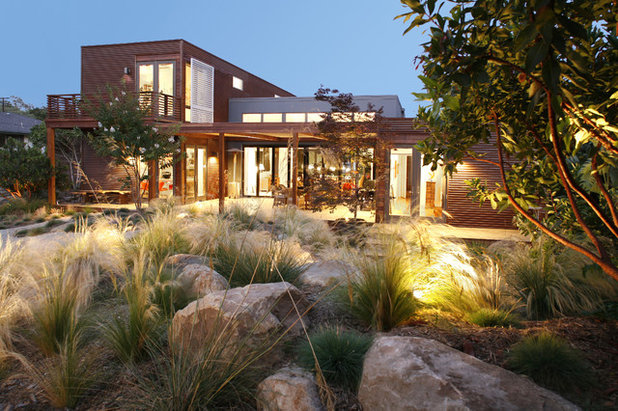
Margie Grace - Grace Design Associates
Light sources from both inside and outside the house combine to light this garden.

Margie Grace - Grace Design Associates
Low-voltage landscape lighting allows this Asian-inspired courtyard garden to be enjoyed night or day, from inside the house or within the garden walls.
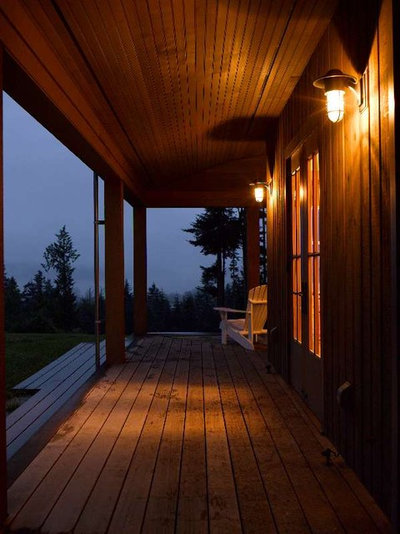
Bosworth Hoedemaker
Tip: Consider all sources of light when lighting a landscape
.Although mounted on the house, these sconce lights greatly impact the net effect of the landscape lighting. Perfectly placed for safely navigating the step at the edge of the deck, approaching the house and determining where the door is, they're likely to be too strong for any landscape lighting in this rural location. Consider putting a dimmer switch on such fixtures so that you can adjust the ambient light to fit your mood.
More Tips:- Motion sensors. Consider motion sensors to activate some or all of the "functional" lights — the safety and security ones — only when needed.
- Balance. Look for balance in the overall composition once you've set your lights up. Adjust as needed.
- Easy does it. It's hard on the eyeballs to move from brightly lit spaces to unlit spaces. Try a subtle overall wash of light versus sporadic bright lights. Consider also the ambient light when selecting wattage: If you've got a street light shining into your front yard, for instance, you're going to need to use stronger landscape lighting for it to even show up. Finally, consider adding a dimmer or lowering the wattage of the existing fixtures mounted on the outside (and the inside) of the house. With a dimmer you'll be able to lower the lights to fit your mood or crank them up to accomplish a task (barbecuing, finding your contact lens or performing an open-air operation, for instance).
- Night sky–friendly lighting. Minimize the use of uplights to reduce light pollution; this is a code requirement in some localities.
- Hot spots. Or what I refer to as "light stabbing you in the eye." Check for these when your lighting is done. Adjust the orientation of the light fixture, add a shield, lower the wattage, move or eliminate the offending fixture etc. Low-voltage fixtures are easily adjusted to get the mood just right.





